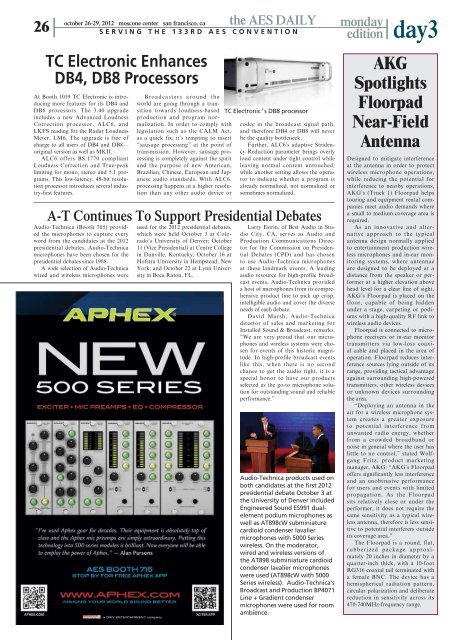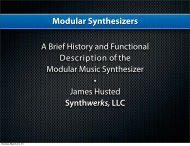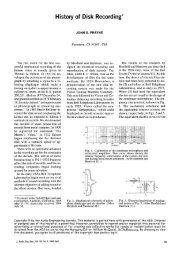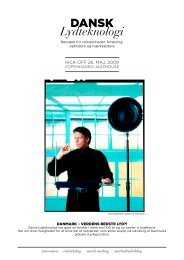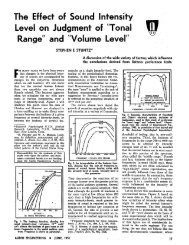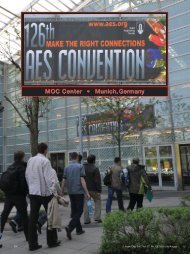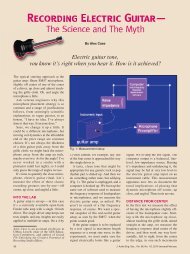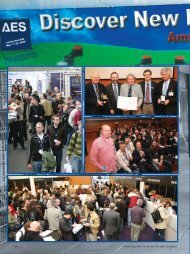Day 3 - Monday Edition - Audio Engineering Society
Day 3 - Monday Edition - Audio Engineering Society
Day 3 - Monday Edition - Audio Engineering Society
Create successful ePaper yourself
Turn your PDF publications into a flip-book with our unique Google optimized e-Paper software.
october 26-29, 2012 moscone center san francisco, ca the AES DAILY<br />
26 monday<br />
day3<br />
Serving the 133rd AeS Convention edition<br />
tC electronic enhances<br />
dB4, dB8 Processors<br />
At Booth 1019 TC Electronic is introducing<br />
more features for its DB4 and<br />
DB8 processors. The 3.40 upgrade<br />
includes a new Advanced Loudness<br />
Correction processor, ALC6, and<br />
LKFS reading for the Radar Loudness<br />
Meter, LM6. The upgrade is free of<br />
charge to all users of DB4 and DB8—<br />
original version as well as MKII.<br />
ALC6 offers BS.1770 compliant<br />
Loudness Correction and True-peak<br />
limiting for mono, stereo and 5.1 programs.<br />
This low-latency, 48-bit resolution<br />
processor introduces several industry-first<br />
features.<br />
A-T Continues To Support Presidential Debates<br />
<strong>Audio</strong>-Technica (Booth 705) provided<br />
the microphones to capture every<br />
word from the candidates at the 2012<br />
presidential debates. <strong>Audio</strong>-Technica<br />
microphones have been chosen for the<br />
presidential debates since 1988.<br />
A wide selection of <strong>Audio</strong>-Technica<br />
wired and wireless microphones were<br />
Broadcasters around the<br />
world are going through a transition<br />
towards loudness-based<br />
production and program normalization.<br />
In order to comply with<br />
legislation such as the CALM Act,<br />
as a quick fix, it’s tempting to insert<br />
“sausage processing” at the point of<br />
transmission. However, sausage processing<br />
is completely against the spirit<br />
and the purpose of new American,<br />
Brazilian, Chinese, European and Japanese<br />
audio standards. With ALC6,<br />
processing happens at a higher resolution<br />
than any other audio device or<br />
used for the 2012 presidential debates,<br />
which were held October 3 at Colorado’s<br />
University of Denver; October<br />
11 (Vice Presidential) at Centre College<br />
in Danville, Kentucky; October 16 at<br />
Hofstra University in Hempstead, New<br />
York; and October 22 at Lynn University<br />
in Boca Raton, FL.<br />
TC Electronic’s DB8 processor<br />
codec in the broadcast signal path,<br />
and therefore DB4 or DB8 will never<br />
be the quality bottleneck.<br />
Further, ALC6’s adaptive Stridency<br />
Reduction parameter brings overly<br />
loud content under tight control while<br />
leaving normal content untouched,<br />
while another setting allows the operator<br />
to indicate whether a program is<br />
already normalized, not normalized or<br />
sometimes normalized.<br />
Larry Estrin, of Best <strong>Audio</strong> in Studio<br />
City, CA, serves as <strong>Audio</strong> and<br />
Production Communications Director<br />
for the Commission on Presidential<br />
Debates (CPD) and has chosen<br />
to use <strong>Audio</strong>-Technica microphones<br />
at these landmark events. A leading<br />
audio resource for high-profile broadcast<br />
events, <strong>Audio</strong>-Technica provided<br />
a host of microphones from its comprehensive<br />
product line to pick up crisp,<br />
intelligible audio and cover the diverse<br />
needs of each debate.<br />
David Marsh, <strong>Audio</strong>-Technica<br />
director of sales and marketing for<br />
Installed Sound & Broadcast, remarks,<br />
“We are very proud that our microphones<br />
and wireless systems were chosen<br />
for events of this historic magnitude.<br />
In high-profile broadcast events<br />
like this, when there is no second<br />
chance to get the audio right, it is a<br />
special honor to have our products<br />
selected as the go-to microphone solution<br />
for outstanding sound and reliable<br />
performance.”<br />
<strong>Audio</strong>-Technica products used on<br />
both candidates at the first 2012<br />
presidential debate October 3 at<br />
the University of Denver included<br />
Engineered Sound ES991 dualelement<br />
podium microphones as<br />
well as AT898cW subminiature<br />
cardioid condenser lavalier<br />
microphones with 5000 Series<br />
wireless. On the moderator,<br />
wired and wireless versions of<br />
the AT898 subminiature cardioid<br />
condenser lavalier microphones<br />
were used (AT898cW with 5000<br />
Series wireless). <strong>Audio</strong>-Technica’s<br />
Broadcast and Production BP4071<br />
Line + Gradient condenser<br />
microphones were used for room<br />
ambience.<br />
AKG<br />
Spotlights<br />
Floorpad<br />
Near-Field<br />
Antenna<br />
Designed to mitigate interference<br />
at the antenna in order to protect<br />
wireless microphone operations,<br />
while reducing the potential for<br />
interference to nearby operations,<br />
AKG’s (Truck 1) Floorpad helps<br />
touring and equipment rental companies<br />
meet audio demands where<br />
a small to medium coverage area is<br />
required.<br />
As an innovative and alternative<br />
approach to the typical<br />
antenna design normally applied<br />
to entertainment production wireless<br />
microphones and in-ear monitoring<br />
systems, where antennae<br />
are designed to be deployed at a<br />
distance from the speaker or performer<br />
at a higher elevation above<br />
head level for a clear line of sight,<br />
AKG’s Floorpad is placed on the<br />
floor, capable of being hidden<br />
under a stage, carpeting or podiums<br />
with a high-quality RF link to<br />
wireless audio devices.<br />
Floorpad is connected to microphone<br />
receivers or in-ear monitor<br />
transmitters via low-loss coaxial<br />
cable and placed in the area of<br />
operation. Floorpad reduces interference<br />
sources lying outside of its<br />
range, providing tactical advantage<br />
against surrounding high-powered<br />
transmitters, other wireless devices<br />
or unknown devices surrounding<br />
the area.<br />
“Deploying an antenna in the<br />
air for a wireless microphone system<br />
creates a greater exposure<br />
to potential interference from<br />
unwanted radio energy, whether<br />
from a crowded broadband or<br />
noise in general where the user has<br />
little to no control,” stated Wolfgang<br />
Fritz, product marketing<br />
manager, AKG. “AKG’s Floorpad<br />
offers significantly less interference<br />
and an unobtrusive performance<br />
for users and events with limited<br />
propagation. As the Floorpad<br />
sits relatively close or under the<br />
performer, it does not require the<br />
same sensitivity as a typical wireless<br />
antenna, therefore is less sensitive<br />
to potential interferers outside<br />
its coverage area.”<br />
The Floorpad is a round, flat,<br />
rubberized package approximately<br />
20 inches in diameter by a<br />
quarter-inch thick, with a 10-foot<br />
RG316 coaxial tail terminated with<br />
a female BNC. The device has a<br />
hemispherical radiation pattern,<br />
circular polarization and deliberate<br />
reduction in sensitivity across its<br />
470-740MHz-frequency range.


